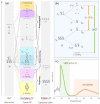A Single Crystal Hybrid Ligand Framework of Copper(II) with Stable Intrinsic Blue-Light Luminescence in Aqueous Solution
- PMID: 34578597
- PMCID: PMC8471168
- DOI: 10.3390/nano11092281
A Single Crystal Hybrid Ligand Framework of Copper(II) with Stable Intrinsic Blue-Light Luminescence in Aqueous Solution
Abstract
Single-crystal solid-liquid dual-phase hybrid organic-inorganic ligand frameworks with reversible sensing response facilitated by external stimuli have received significant attention in recent years. This report presents a significant leap in designing electronic structures that display reversible dual-phase photoluminescence properties from single-crystal hybrid ligand frameworks. Three-dimensional Cu(C3N2H4)4Cl2 complex frameworks were formed through the intermolecular hydrogen bonding and π⋯π stacking supramolecular interactions. The absorption band peaks at 627 nm were assigned to d-d transition showing 10Dq = 15,949 cm-1 and crystal field stabilization energy (CFSE) = 0.6 × 10Dq = 114.4 kJmol-1, while the ligand-to-metal charge transfer (LMCT) of complexes was displayed at 292 nm. The intense luminescence band results from LMCT present at 397 nm. Considering its structure, air stability, framework forming and stable luminescence in aqueous solution, the Cu(C3N2H4)4Cl2 complex shows potential for luminescence Cu-based sensors using emission intensity to detect heavy metal ion species.
Keywords: 3D network complexes; copper coordination complexes; crystal structure; electronic structure; luminescence.
Conflict of interest statement
The authors declare no conflict of interest.
Figures







References
-
- Wang Q., Gao Q., Al-Enizi A.M., Nafady A., Ma S. Recent advances in MOF-based photocatalysis: Environmental remediation under visible light. Inorg. Chem. Front. 2019;7:300–339. doi: 10.1039/C9QI01120J. - DOI
LinkOut - more resources
Full Text Sources

